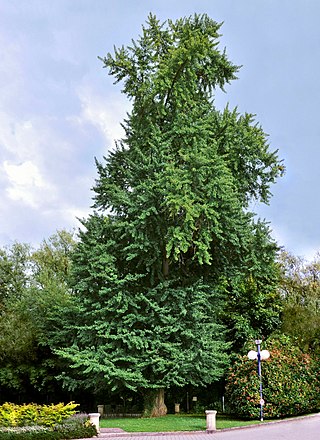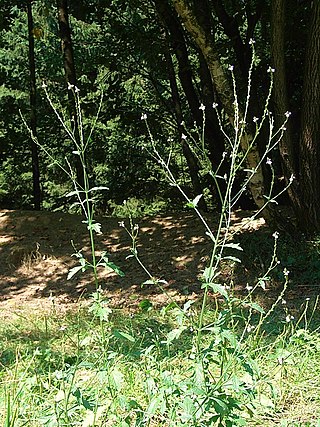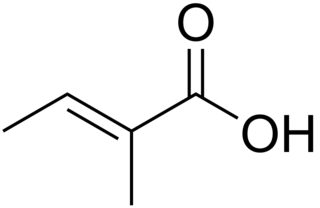
Cashew is the common name of a tropical evergreen tree Anacardium occidentale, in the family Anacardiaceae. It is native to South America and is the source of the cashew nut and the cashew apple, an accessory fruit. The tree can grow as tall as 14 metres, but the dwarf cultivars, growing up to 6 m (20 ft), prove more profitable, with earlier maturity and greater yields. The cashew nut is edible and is considered eaten on its own as a snack, used in recipes, or processed into cashew cheese or cashew butter. The nut is often simply called a 'cashew'. Cashew can cause allergies triggered by the proteins found in the nuts.

Ginkgo biloba, commonly known as ginkgo or gingko, also known as the maidenhair tree, is a species of gymnosperm tree native to East Asia. It is the last living species in the order Ginkgoales, which first appeared over 290 million years ago, and fossils very similar to the living species, belonging to the genus Ginkgo, extend back to the Middle Jurassic epoch approximately 170 million years ago. The tree was cultivated early in human history and remains commonly planted, and is widely regarded as a living fossil.

Toxicodendron is a genus of flowering plants in the sumac family, Anacardiaceae. It contains trees, shrubs and woody vines, including poison ivy, poison oak, and the lacquer tree. All members of the genus produce the skin-irritating oil urushiol, which can cause a severe allergic reaction. The generic name is derived from the Greek words τοξικός (toxikos), meaning "poison," and δένδρον (dendron), meaning "tree". The best known members of the genus in North America are poison ivy (T. radicans), practically ubiquitous throughout most of eastern North America, and western poison oak, similarly ubiquitous throughout much of the western part of the continent.

The ackee, also known as acki, akee, or ackee apple, is a fruit of the Sapindaceae (soapberry) family, as are the lychee and the longan. It is native to tropical West Africa. The scientific name honours Captain William Bligh who took the fruit from Jamaica to the Royal Botanic Gardens in Kew, England, in 1793. The English common name is derived from the West African Akan akye fufo.

Prunus laurocerasus, also known as cherry laurel, common laurel and sometimes English laurel in North America, is an evergreen species of cherry (Prunus), native to regions bordering the Black Sea in southwestern Asia and southeastern Europe, from Albania and Bulgaria east through Turkey to the Caucasus Mountains and northern Iran.

Xanthium (cocklebur) is a genus of flowering plants in the tribe Heliantheae within the family Asteraceae, native to the Americas and eastern Asia and some parts of south Asia.

Cassia fistula, also known as golden shower, purging cassia, Indian laburnum, Kani Konna ,, Konna Poo or pudding-pipe tree, is a flowering plant in the family Fabaceae. The species is native to the Indian subcontinent and adjacent regions of Southeast Asia. It is the official state flower of Kerala state in India. It is also a popular ornamental plant and is also used in herbal medicine.
Neurolathyrism, is a neurological disease of humans, caused by eating certain legumes of the genus Lathyrus. This disease is mainly associated with the consumption of Lathyrus sativus and to a lesser degree with Lathyrus cicera, Lathyrus ochrus and Lathyrus clymenum containing the toxin ODAP.

Croton is an extensive plant genus in the spurge family, Euphorbiaceae. The plants of this genus were described and introduced to Europeans by Georg Eberhard Rumphius. The common names for this genus are rushfoil and croton, but the latter also refers to Codiaeum variegatum. The generic name comes from the Greek κρότος, which means "tick" and refers to the shape of the seeds of certain species.

Crotonic acid ((2E)-but-2-enoic acid) is a short-chain unsaturated carboxylic acid described by the formula CH3CH=CHCO2H. The name crotonic acid was given because it was erroneously thought to be a saponification product of croton oil. It crystallizes as colorless needles from hot water. With a cis-alkene, Isocrotonic acid is an isomer of crotonic acid. Crotonic acid is soluble in water and many organic solvents. Its odor is similar to that of butyric acid.

Yam is the common name for some plant species in the genus Dioscorea that form edible tubers.

Verbena officinalis, the common vervain or common verbena, is a perennial herb native to Europe. It grows up to 70 cm high, with an upright habitus. The lobed leaves are toothed, and the delicate spikes hold clusters of two-lipped mauve flowers.

Senna tora is a plant species in the family Fabaceae and the subfamily Caesalpinioideae. Its name is derived from its Sinhala name tora (තෝර). It grows wild in most of the tropics and is considered a weed in many places. Its native range is in Central America. Its most common English name is sickle senna or sickle wild sensitive-plant. Other common names include sickle pod, tora, coffee pod and foetid cassia. It is often confused with Chinese senna or sickle pod, Senna obtusifolia.

Lupin or lupini are the yellow legume seeds of the genus Lupinus. They are traditionally eaten as a pickled snack food, primarily in the Mediterranean basin, Latin America and North Africa. The most ancient evidence of lupin is from ancient Egypt, dating back to the 22nd century BCE. The bitter variety of the beans are high in alkaloids and are extremely bitter unless rinsed methodically. Low alkaloid cultivars called sweet lupins have been bred, and are increasingly planted.

Adenanthera pavonina is a perennial and non-climbing species of leguminous tree. Its uses include food and drink, traditional medicine, and timber.

Tiglic acid is a monocarboxylic unsaturated organic acid. It is found in croton oil and in several other natural products. It has also been also isolated from the defensive secretion of certain beetles.

Gliricidia sepium, often simply referred to as gliricidia or by its Spanish common name madre de cacao, is a medium size leguminous tree belonging to the family Fabaceae. It is an important multi-purpose legume tree, with a native range from Mexico to Colombia, but now widely introduced to other tropical zones.
Scarification in botany involves weakening, opening, or otherwise altering the coat of a seed to encourage germination. Scarification is often done mechanically, thermally, and chemically. The seeds of many plant species are often impervious to water and gases, thus preventing or delaying germination. Any process designed to make the testa more permeable to water and gases is known as scarification.


















